Central - Chuzan
Included in this section
- ⭐⭐Agena Castle
- ⭐⭐⭐Katsuren Castle (UNESCO 972-005)
- ⭐⭐⭐Nakagusuku Castle (UNESCO 972-006)
- ⭐⭐⭐Shuri Castle (UNESCO 972-007)
- ⭐⭐Urasoe Castle
- ⭐⭐⭐Zakimi Castle (UNESCO 972-004)
Agena Castle (安慶名城跡)
⭐⭐ Good
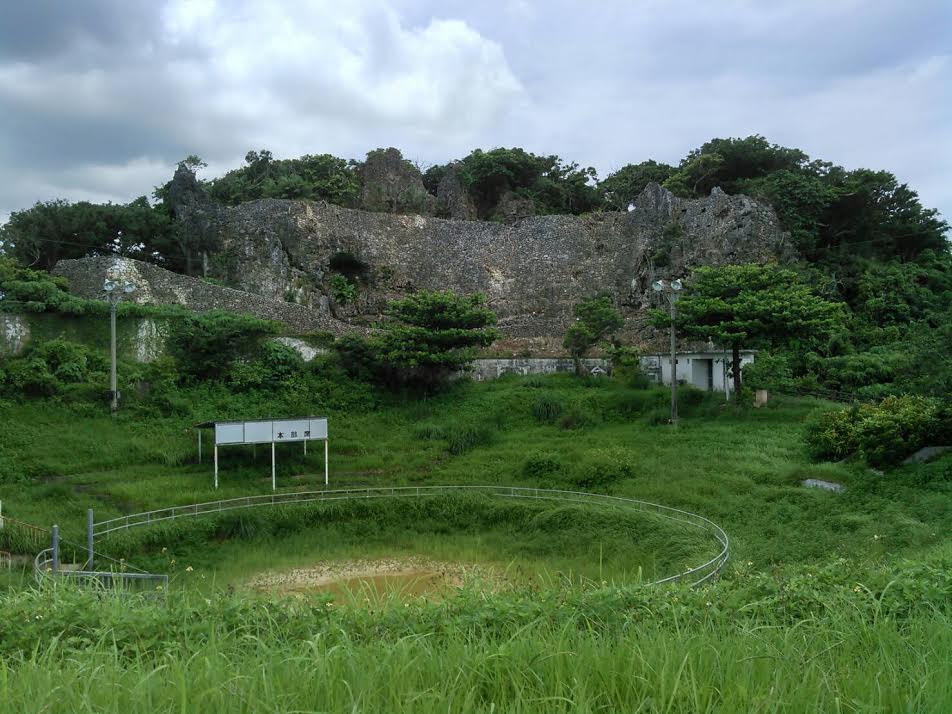
Okiu fs, CC BY-SA 4.0, via Wikimedia Commons
Castle Data
- Dimensions: 55 m x 65 m
- Constructed: 14th century
- Lat/Long: 26.3809, 127.8504
- Google Maps: Agena Castle Ruins
- Elevation: 49 m
Points of Interest
- Massive, nozura (stacked stone) north-east wall
- Spectacular view of the bullring and Uruma city
- Original stone steps and walls
- Jungle adventure vibe with shade
- Agena Bullring (安慶名闘牛場)
- War Memorial (慰霊顕彰碑)
Getting There and Parking
- Distance: 34 km north of Naha / 9 km north-east of Okinawa City
- Car: Navigate to Agenachuo Koen Parking Lot, 1045 Agena, Uruma, Okinawa 904-2214, Japan. (安慶名中央公園 駐車場)
- Parking: Parking lot closed for COVID (Spots for about 60 cars)
- Admission: no charge
- Hours: 24 h
- https://www.city.uruma.lg.jp/bunka/2399
Where to Eat
- Sushiro (スシロー うるまみどり町店), 6 Chome-1-21 Midorimachi, Uruma, Okinawa 904-2215, Japan. https://www.akindo-sushiro.co.jp/menu/
- Ramen Ōzakura (ラーメン大桜 うるま店), 1 Chome-1-13 Midorimachi, Uruma, Okinawa 904-2215, Japan. https://www.oozakura.com/
Side Trip
- Chichi Gusuku (Tengen Gusuku) (天願グスク) (inside USMC Camp Courtney) - 1.6 km
- Uken Beach (宇堅ビーチ) - 3 km
- Chibana Castle Ruins (知花グスク) - 6.7 km
- Southeast Botanical Gardens 美らヤシパークオキナワ・東南植物楽園 - 6.7 km
- Katsuren Castle Ruins (勝連城跡) - 7.4 km
Maps - Agena Castle
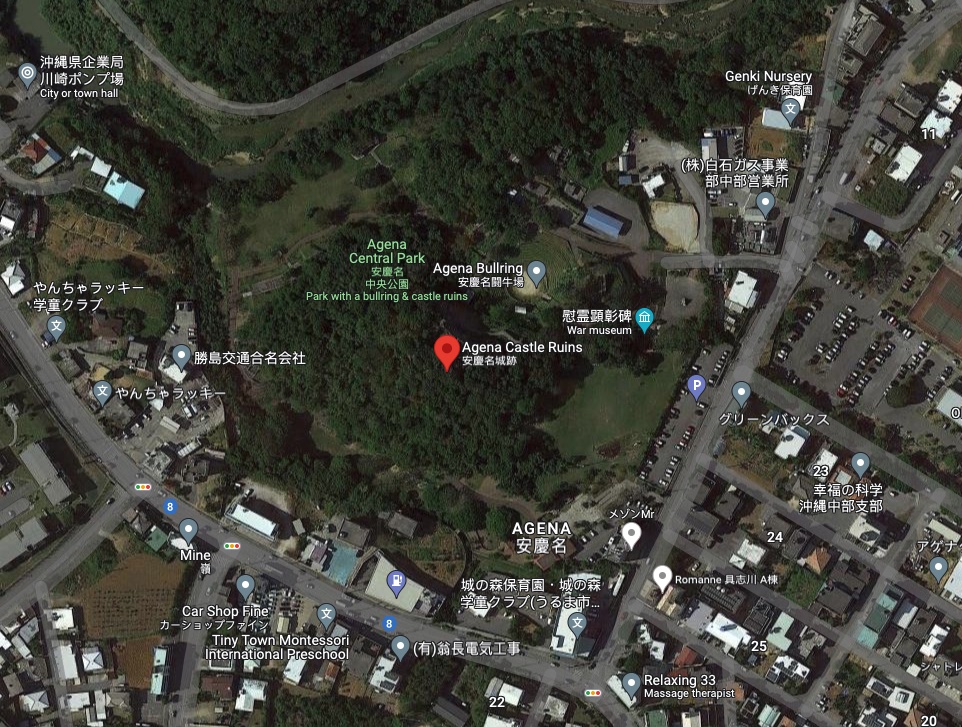
Map data ©2023 Google
Overview - Agena Castle
This is a mountain top castle that uses the natural landscape of the river and cliffs to its advantage, and like Kakinohana Castle, it has an Indiana Jones / lost in the jungle vibe, with great views from the top. The castle is easily overlooked as it’s in the middle of town, and walking distance from the US Marine Corps Camp McTureous, being on its eastern boundary. It’s also overshadowed by the Agena Bullring, and just aching to be explored. Agena Castle is in central Okinawa, and on the east side of the island. Kin Bay is just to its north east, and the Tengan River meanders along its north side. It has a number of distinct features including nozura (stacked stone) walls, original stairways, a couple of baileys, a natural cave-like entrance, a viewing port and some interesting rock formations. It was designated as a Nationally Designated Cultural Property S47-5-165 on 15 May 1972.
On The Trail - Agena Castle
From the left or south end of the parking lot, make your way across the park lawn toward the left side of the verdant hill. You’ll soon see a cluster of monuments.
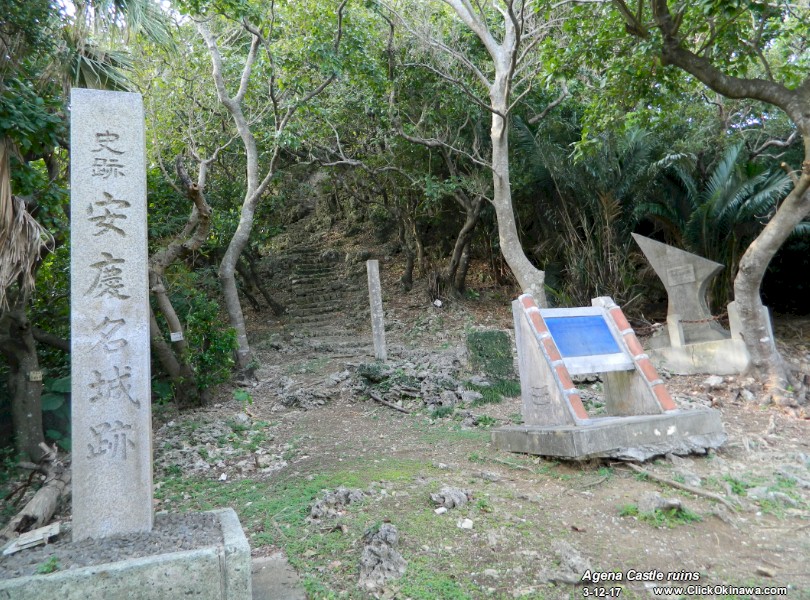
Okinawaphile, CC BY-SA 4.0, via Wikimedia Commons
The leftmost vertical stone marker says (on multiple sides):
Historical site Agena Castle Ruins, National Designated Property 15 May 1972
The concrete & tile monument with a bluish colored brass plaque says:
Agena Castle Ruins Akena Castle is said to have been built by Agena Okawa Aji around the 14th century, and is also known as Okawa Castle. Cliffs were skillfully used as castle walls, and the castle walls were built from the middle of the mountain by the Nozura method.The central part is the summit plateau. A stone stairway is installed along the slope from the lower east side to the castle gate that opens on the south side of the interior. The castle gate is partly cut down using a crack in the natural bedrock, and then further the castle gates are spaced relatively narrowly at 1.0m, and near the center of the interior there are thresholds and lintel holes on both sides for attaching doors. Chinese ceramics and earthenware from the Gusuku period have been excavated from within the castle.
Make your way into the tree covered jungle up the stairs and feel how the atmosphere changes. Advance a little more than 1/2 the way up and there’s a little landing where the trail splits. The left fork heads up to the left where you can see a bench at the top, and the right fork heads for a few more feet through the jungle and becomes the top of the thick, wide outer wall. Most castles would have signs at this point saying stay off the walls, so please use discretion and good judgment. Back at the fork on the staircase, head to the left, up the last few dozen steps to the bench.

Okinawaphile, CC BY-SA 4.0, via Wikimedia Commons
Just before you reach the bench, you’ll see a small tomb built into the right hand cliff with nuno-zumi cut limestone blocks. This style of stone work - Ashlar masonry - is different from most of the existent walls and is often reserved for important features like gates, and strongly fortified walls. It’s not clear if this is the tomb of the last Aji (ruler) of Agena castle. At the top of the staircase, take a breather on the concrete bench if you’d like, and take in the natural surroundings, the light in the trees, and the roots that seem to be hugging the old walls. When you’re ready, make a hairpin right turn and head up the last few rough steps to the inner castle gate.
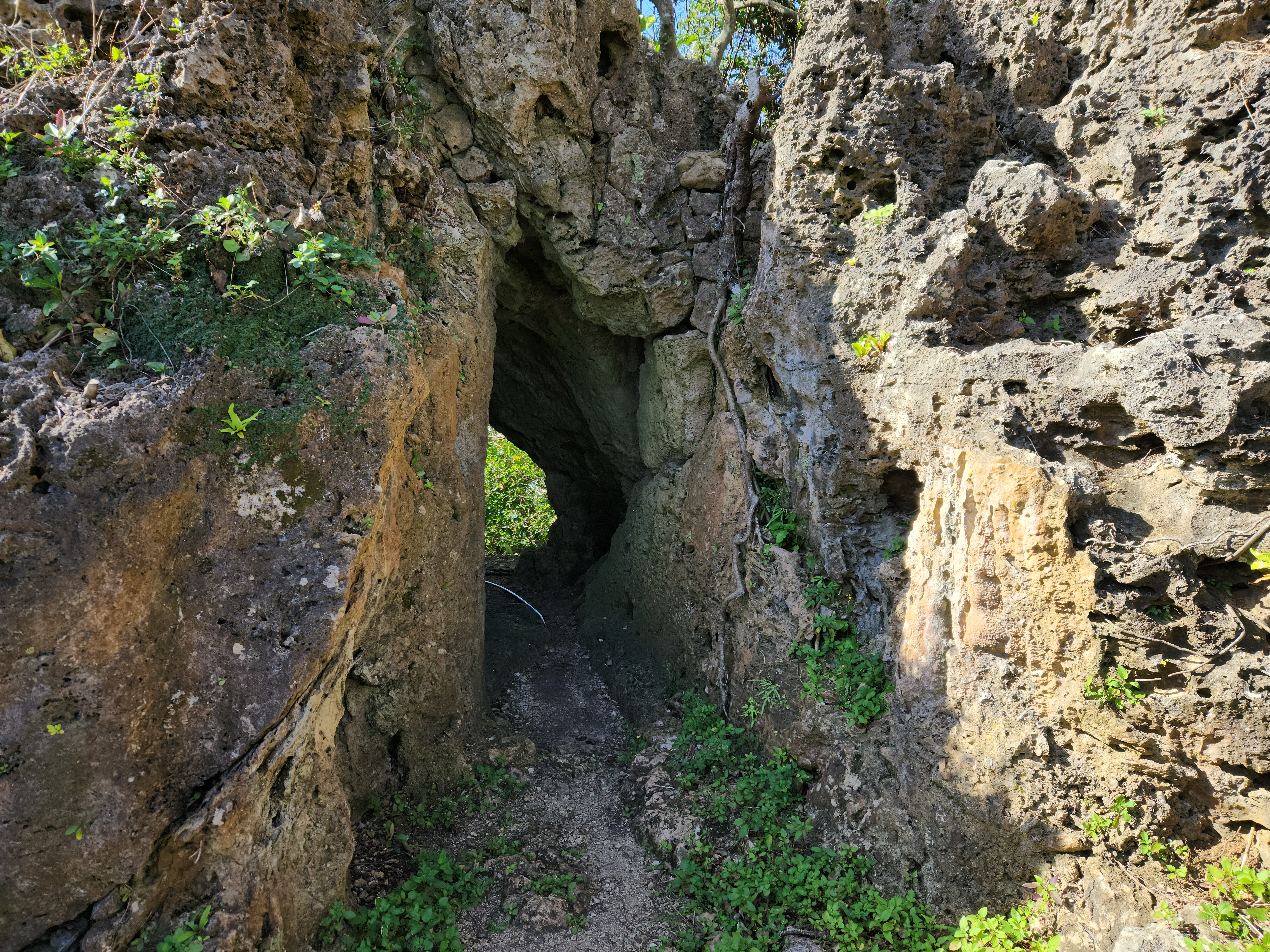
Juniper, CC BY-SA 4.0, via Wikimedia Commons
The gate utilizes a low, natural stone arch, and is narrowed to about 1 m in width by more nuno-zumi cut limestone blocks along one side. My own theory is that this natural funnel would prevent horses from entering the top of the castle, and be much easier to defend. It might also help to emphasize the religious importance of the site, since most gusuku seem to have been built at utaki (holy) sites. Whether it was a military tactic, or religious-political theater, it is pretty special to squeeze through the ancient gate, and be greeted by the bright sky, vertical limestone formations that separate the two main areas (baileys). Head to the left and you’ll come close to the edge of the wall, and be rewarded with great views of Agena Bullring below and Uruma City. There’s a bench here too if you’d like to just enjoy the view and air up here. Continuing to the left, it opens up to a partially shaded grassy area with low stone walls.
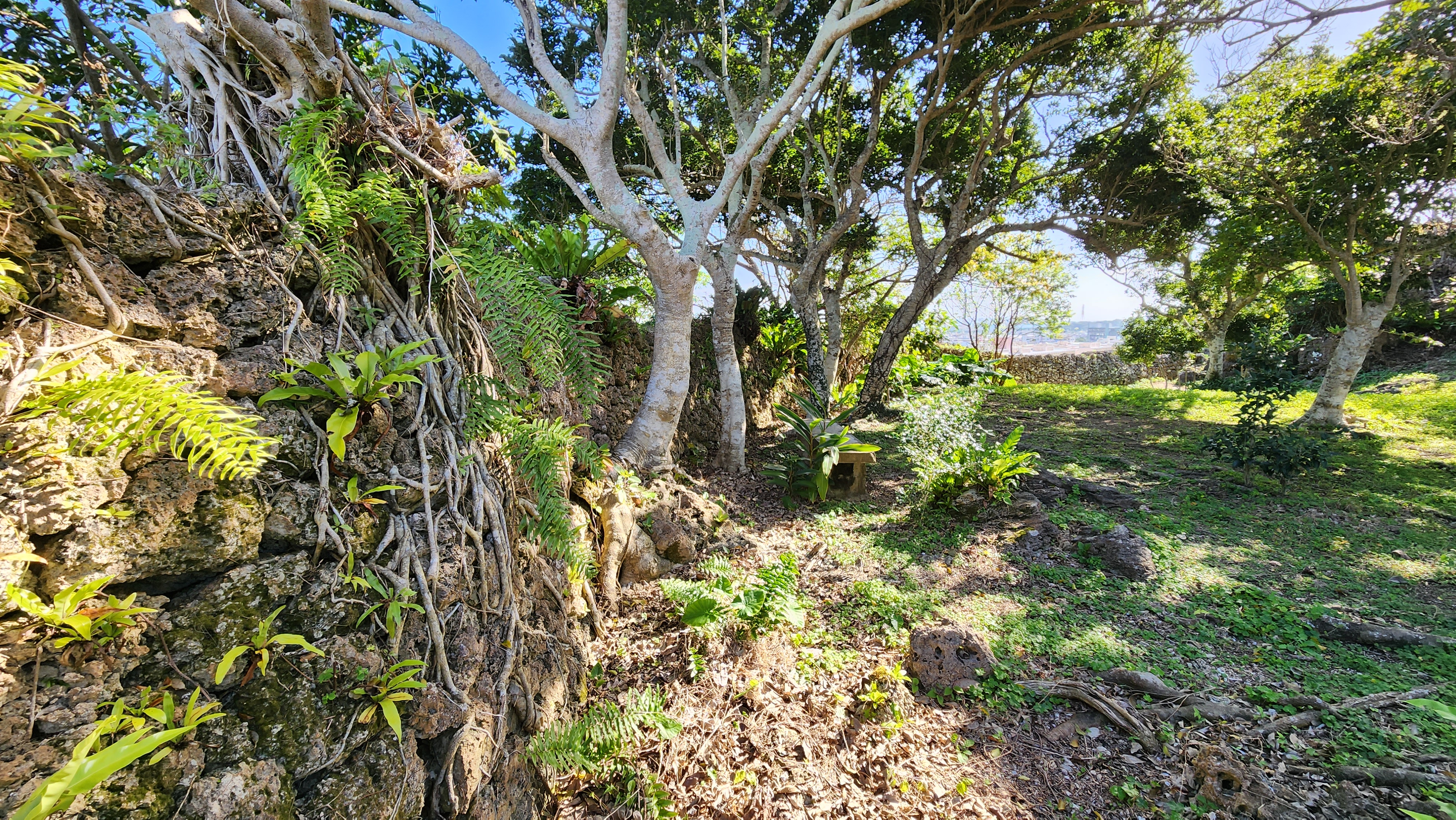
Juniper, CC BY-SA 4.0, via Wikimedia Commons
If you keep curving to the left you’ll see what looks like a wide trail that heads upwards, keep going and you’ll end up climbing up the jagged limestone that will remind you of coral at low tide, up to the highest point in the castle. Stand on the bench and you’ll get a view of the Agena Middle School and USMC Camp McTureous. Head back down, and investigate this larger of the two castle open areas. Notice that most of the +600 year old stone walls that line the perimeter here are hand stacked limestone in the nozura-zumi style. When you’re ready, backtrack and check out the 2nd and smaller bailey that was to the right of the gate. While here, look for a small square hole in the wall that is an example of an opening that could be used for defending the castle with archers or possibly fire bombs.
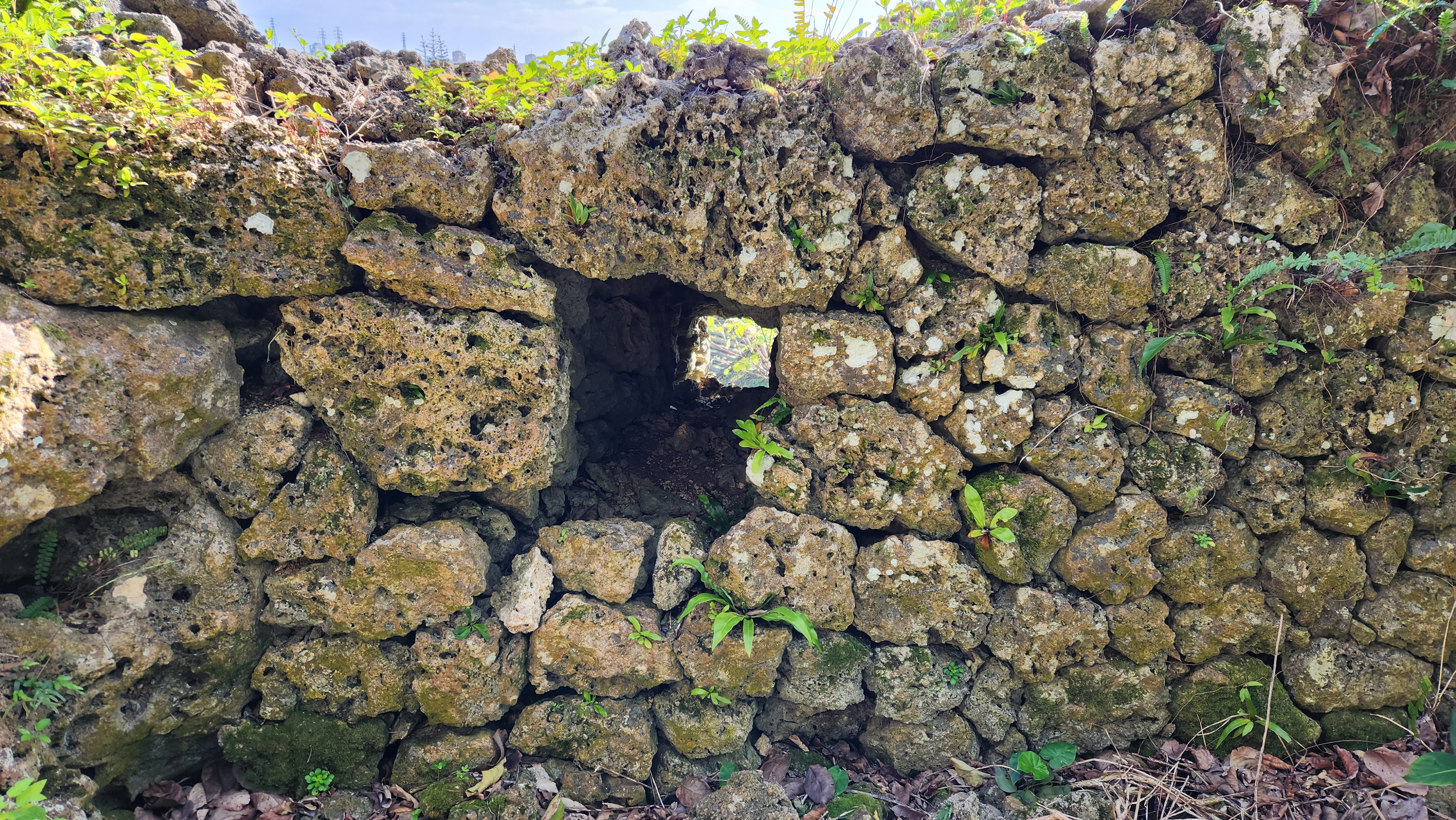
Juniper, CC BY-SA 4.0, via Wikimedia Commons
I can imagine the original walls could have contained many such openings at advantageous positions with overlapping fields of fire, to help defend the castle. While up here, keep your eye out for a number of small shrines with offerings.

Juniper, CC BY-SA 4.0, via Wikimedia Commons
Strategically, this castle is in a great hilltop position, but has a weakness because the river would have been far below during a siege. Another weakness is it’s so close to town and the jungle has overgrown it’s walls that it’s easy to be overlooked, but this small, special castle is eagerly waiting for you to explore it.
Katsuren Castle (勝連城跡)
⭐⭐⭐ Great

kanegen, CC BY 2.0, via Wikimedia Commons
Castle Data
- Dimensions: 140 m x 85 m
- Constructed: 12th century
- Lat/Long: 26.3304, 127.8782
- Google Maps: Katsuren Castle Ruins
- Elevation: 98 m
Points of Interest
- Views of the Pacific Ocean on two sides
- UNESCO World Heritage Site (UNESCO 972-005)
- In 2016, archaeologists unearthed medieval Ottoman and ancient Roman coins
- Year round activities & events, check their website
Getting There and Parking
- Distance: 33 km north of Naha
- Car: Navigate to Amawari Park, 3807-2 Katsurenhaebaru, Uruma, Okinawa 904-2311, Japan. (あまわりパーク)
- Parking: Spots for about 170 cars plus motorcycles and buses
- Restrooms: Yes
- Admission: ¥600 adults, ¥400 for 6-12yrs, free under 6
- Hours: 9am-6pm
- https://www.katsuren-jo.jp
Where to Eat
- Churakaji (ちゅらかじ), 1378-2 Katsurenhenna, Uruma, Okinawa 904-2312, Japan. https://www.cyurakaji.com/food
- Uruma Gelato (うるまジェラート) https://urugela.com / BBQ Teruma (東海岸) 1860-1 Yonashiroteruma, Uruma, Okinawa 904-2301, Japan.https://www.hotpepper.jp/strJ001267043/course
Side Trip
- Hamahiga Island (浜比嘉島)
- Muruku Beach (ムルク浜ビーチ)
- Tomb of Amamichu (アマミチューの墓), who was the creator god of Ryukyu Islands
- Shirumichu Cave (シルミチュー) - home of Amamichu and Shirumichu gods
Maps - Katsuren Castle

Map data ©2024 Google

Map data ©2024 Google
Overview - Katsuren Castle
Katsuren Castle (勝連城, Katsuren jō, Okinawan: Kacchin Gushiku), perched atop a 98-meter (322 ft) limestone crag on the Katsuren Peninsula, is a sight to behold. The ruins of this 13th-14th century castle, designated a UNESCO World Heritage Site in 2000, offer stunning views of the Pacific Ocean – making it easy to see why it's called the "Ocean Gusuku". Imagine the power of the Aji of Katsuren, Amawari, who ruled during the castle's "golden age" in the mid-15th century. Amawari's ambition and eventual downfall at the hands of the Ryukyuan army in 1458 are significant events in Okinawan history. You can almost hear the shuffle of feet and the shouts of guards as you walk through the gates.
Unlike many gusuku, Katsuren Castle has a distinct five-part layout. The highest point, called the Upper Gusuku, contains the first three baileys – almost a self-contained fortress within the castle walls. The second bailey is where historians believe the main hall once stood, and the first bailey houses a shrine to Kobazukasa. The Lower Gusuku, comprising Bailey 4, boasted five wells, a testament to the castle's ability to withstand a siege. You'll be awed by the castle’s sturdy construction, including examples of nozura-zumi (stacked stone) walls, ingenious water drainage systems and evidence of a moat (堀切, horikiri).
Exploring Katsuren Castle isn't just about marveling at the past – it's about connecting with it. As you stroll through the grounds, remnants of Chinese porcelain and roof tiles hint at a thriving trade network that once flourished here. And don't miss the opportunity to witness a true oddity: the excavation site of ancient Roman and Ottoman coins – the first of its kind in Japan! Whether you're a history buff or just looking for a captivating day trip, Katsuren Castle offers a unique glimpse into Okinawa's fascinating past.
On The Trail - Katsuren Castle
Katsuren Castle (勝連城), a UNESCO World Heritage Site, beckons travelers to uncover its secrets. Perched atop a limestone plateau on the Katsuren Peninsula, this "Ocean Gusuku" affords breathtaking views of the Pacific, serving as a reminder of the powerful Aji who once ruled here. This guide will lead you through the castle’s five baileys, highlighting intriguing details and offering glimpses into Okinawa's captivating past.
Starting Your Journey:
- The Approach: As you ascend the path towards the castle, take a moment to appreciate the panoramic views. Picture the bustling port that once thrived below, connecting Okinawa to a vast trade network.
- Bailey 5 (東グスク): Your journey begins in the easternmost section, Bailey 5. Once thought to be a flat expanse, recent excavations revealed a horikiri (moat), underscoring the castle’s defensive capabilities. Imagine the moat, now filled in, once serving as a formidable obstacle to invaders.
- Bailey 4 (下グスク): Continue your ascent to Bailey 4, the Lower Gusuku. This bailey, with its five wells and two fortified gates, highlights the castle’s self-sufficiency during times of conflict. Look for evidence of these wells, vital sources of life-sustaining water during sieges.
- Bailey 3 (三ノ郭): Make your way up to Bailey 3, stopping to admire the gusuku-dō (castle road), a testament to the castle's enduring connection to the spiritual realm. This bailey, where historians believe a wooden gate once stood, offers captivating views of Bailey 2.
- Bailey 2 (二ノ郭): Entering Bailey 2, you'll stand on the grounds where the castle's main hall once commanded attention. Imagine the Aji of Katsuren holding court here, surrounded by advisors and dignitaries. This bailey, the heart of the castle’s political and social life, offers a glimpse into the daily routines of the Aji and his court.
- Bailey 1 (一ノ郭): Finally, ascend to the highest point – Bailey 1. This sacred space is home to a shrine dedicated to Kobazukasa, a testament to the enduring presence of Ryukyuan religion within the castle walls. Take a moment for quiet reflection as you soak in the panoramic views of the Pacific. This vantage point, once a place of worship and strategic observation, offers a 360-degree panorama of the surrounding landscape and ocean.
Don't Miss:
- Stonework: As you explore the different baileys, note the different types of stonework. From the carefully fitted nuno-zumi (masonry) style used for fortified walls to the more rustic nozura-zumi (stacked stone) construction, Katsuren Castle showcases the craftsmanship of the Ryukyuan people.
- Water Drainage System: Look for evidence of the castle's ingenious water drainage system. These strategically placed channels and cisterns helped prevent flooding and ensured a continuous supply of fresh water, a testament to the ingenuity of the Ryukyuan architects.
- Excavation Site: Near the castle, you'll find the excavation site where ancient Roman and medieval Ottoman coins were unearthed – a testament to Okinawa’s far-reaching connections in the past. This unexpected discovery, the first of its kind in Japan, offers a tantalizing glimpse into the island's role in global trade networks.
Reflecting on the Past: As you leave Katsuren Castle, carry with you the stories whispered by the wind through the ruins. This "Ocean Gusuku", with its majestic views and tangible history, is a testament to the ingenuity, resilience, and cultural richness of the Ryukyuan people.
Nakagusuku Castle (中城城跡)
⭐⭐⭐ Great
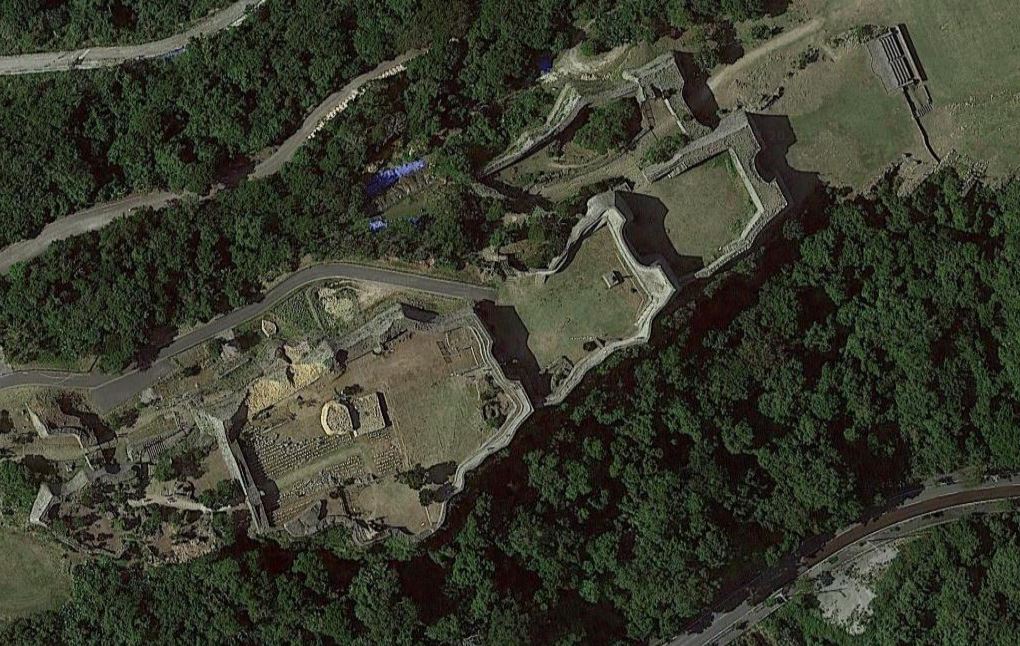
Photo by 663highland/CC BY 2.5
Castle Data
- Dimensions: 58 m x 265 m
- Constructed: 13 - 15th century
- Lat/Long: 26.2839, 127.8013
- Google Maps: Nakagusuku Castle
- Elevation: 150 m
Points of Interest
- Nakagusuku Castle is a UNESCO World Heritage Site (972-006)
- Forge Site
- Walls built in all 3 major styles (nozura, nunozura, aikatazura)
- Multiple wells
- Warrior walkways on the walls
Getting There and Parking
- Car: Navigate to Nakagusuku Castle (中城城跡), 503 Ogusuku, Kitanakagusuku, Nakagami District, Okinawa 901-2314, Japan. This will take you east of Ginowan City and MCAS Futenma, and is sandwiched between the Ocean Castle Country Club, and the Onishi Terrace Golf Club.
- There's parking for +30 cars and multiple spots for tour busses.
- There is a public wheel-chair accessible restroom just inside the entrance on the right.
- Admission is 400¥ for adults and 300/200¥ students and children.
- Hours: 8:30am-5pm.
- https://www.nakagusuku-jo.jp/
Where to Eat
Gabusoka Soba (我部祖河食堂 中城店), 2018-1 Kuba, Nakagusuku, Nakagami District, Okinawa 901-2401, Japan. Hours: 11am-8:30pm. http://www.gabusokasoba.com
Side Trip
Okinawa Naritazan Fukusen Temple 沖縄成田山福泉寺. 617 Ishado, Nakagusuku, Nakagami District, Okinawa 901-2403, Japan. https://okinawa-naritasan.jp
Maps - Nakagusuku Castle
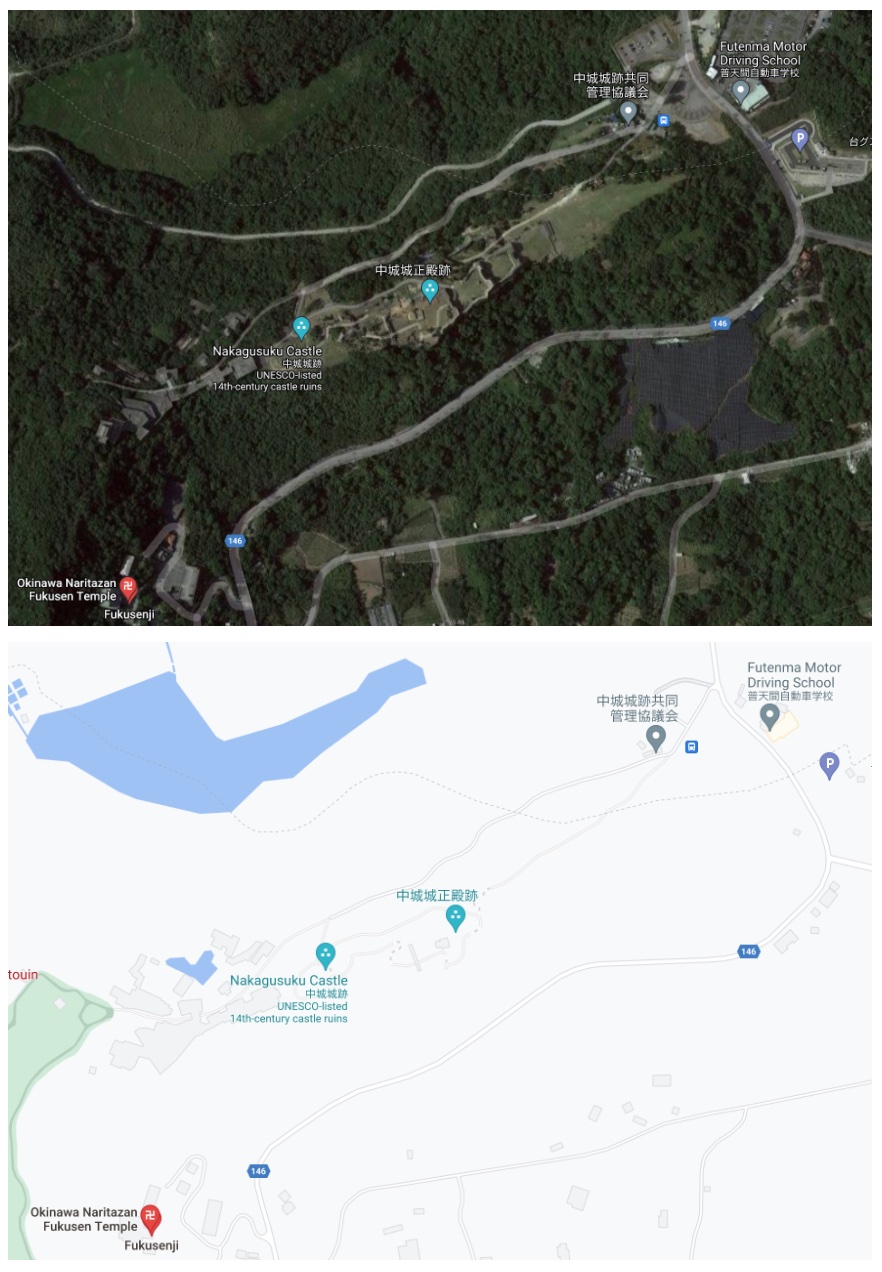
Map data ©2021 Google
Overview - Nakagusuku Castle
The 215m x 80m castle overlooks Nakagusuku Bay and the Philippine Sea to the east. The south east side of the castle is a natural cliff. The castle is fairly linear running from the south east at a diagonal to the north west at an elevation of 100m. There are 6 areas (baileys) enclosed by stone walls still in this castle. The four baileys along the south side are linear, and the other two are along the north side. The majority of the castle is made from cut limestone. The top corners of the walls you will notice have rounded peaks that add to the aesthetic appeal of this castle. The back gate is a beautiful stone arch. The front gate at the top of the stairs is thought to have been built in a tower style. There are 8 sacred places of worship inside the castle, primarily on the west end. There was an iron works onsite and it was believed to be for the production of weapons.
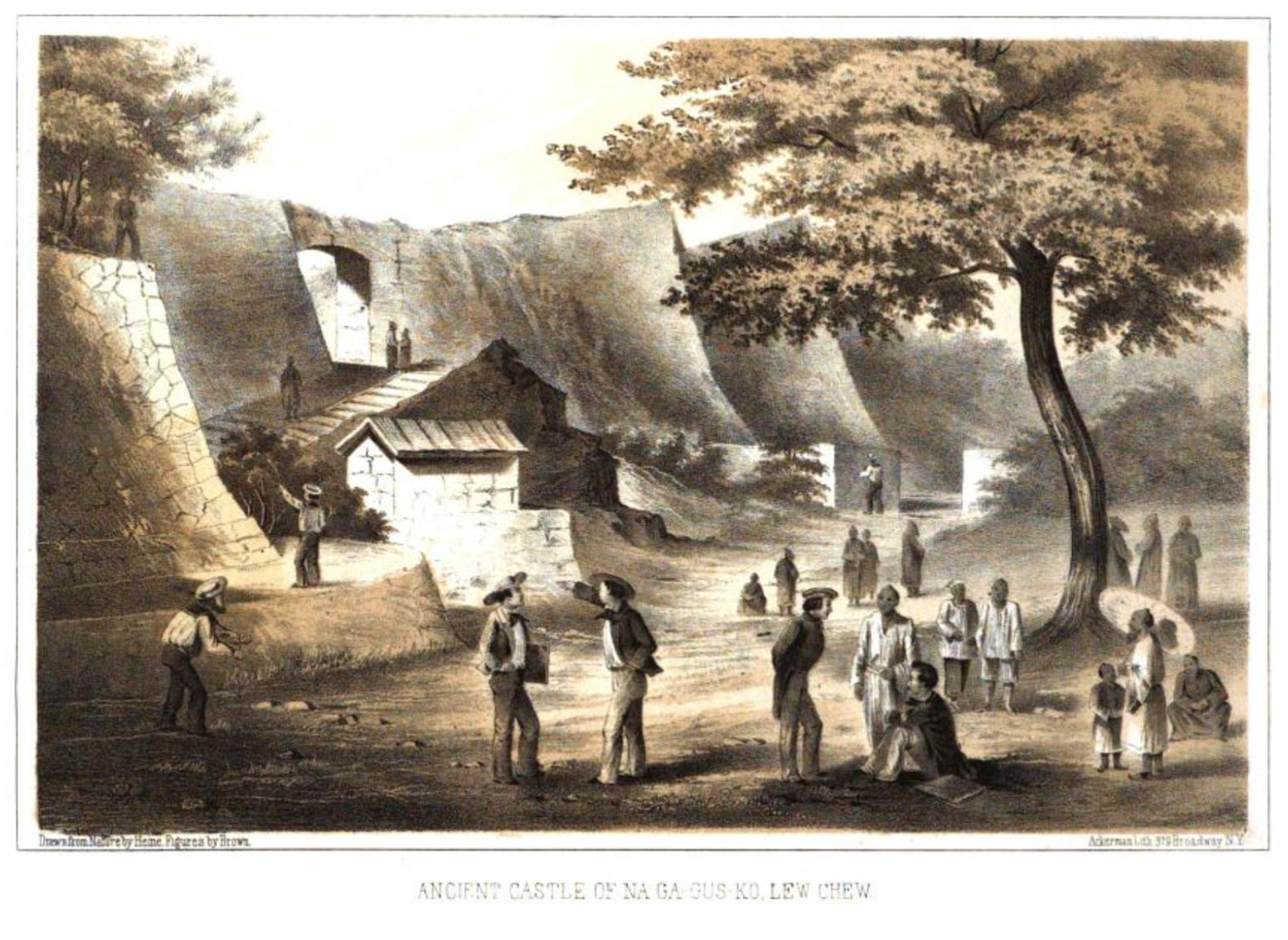
Lithograph by Heine & Brown/Public Domain
Construction occurred from the 13-15th centuries in 2 main stages. Gosamaru was the architect of the castle and took inspiration from Nakijin Castle. The walls are built in three styles. Nozura (rubble) style, the main enclosure (bailey 1) and bailey 2 are made with the nunozumi/tofuzumi (masonry) style, similar to rectangular brickwork. The 3rd bailey on the north east end is the first wall you see from the parking lot and it is by far the thickest and it's built in the aikata (turtleback) style, you'll see the stones each have a unique shape, and fit together very tightly, this make for an extremely strong and stable wall. Wilhelm Heine, drew the castle during Admiral Mathew C. Perry's 1853 expedition to Okinawa, as "Ancient Castle of Na-Ga-Cus-Ko, Lew Chew", seen above.
On The Trail - Nakagusuku Castle
Make your way from the ample parking lot to the kiosk on the right of the path to pay. Continue down the asphalt path along the entire side of the castle, if you're lucky, catch a ride on the golf cart that ferries guests to the front gate. You'll see a black stone UNESCO World Heritage monument.
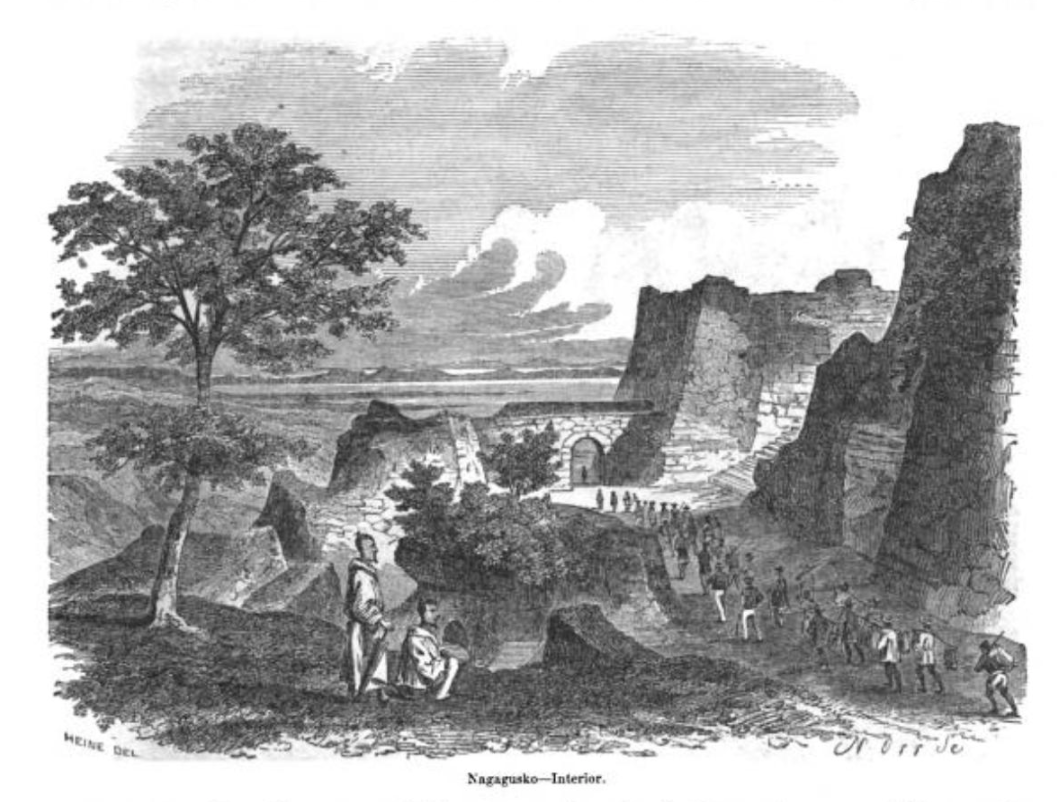
Lithograph by Heine & Brown/Public Domain
Climb the stairs, and a large grassy field opens up to you, and you'll see a signpost guiding you to the Forge Site. As you turn toward the castle, it towers overhead, and the Forge Site is at the base of the cliff slightly to the right of center.
As you face the cliffs, head to your left along the cliffs, and follow the stone path as it heads slightly uphill to the main gate. Notice how tall the walls are here as you approach. If you have the tourist map with you, this section is really small on the map, even though it's an imposing entrance. The walls here are nunozumi, and are rectangular in shape. Ahead on your right, you'll see the white marker for Nakagusuku Castle Ruins.

Photo by 663highland/CC BY-A-2.5
As you enter through the main gate area, it almost feels like a tunnel made from massive stones. As you pass through the gate, you'll see the stone walls on your right for the ramp are made in the aikata (turtleback) style, where the rocks are fitted together. You are now inside the Western bailey. This section is about 120m long and was used in the drilling of soldiers and horse riding.
Make your way up the wooden, and then stone steps to enter the gate into the Southern bailey. You'll see a number of signposts explaining the features, including a number of sacred places of prayer that are still used.
- Sacred Place of Prayer: Utuukura Hinukan (Fire Deity) - Common Name: Shuri Utuushi (Worship Area)
- Sacred Place of Prayer: Kugusuku no Oibe - Common Name: Kudaka Utuushi (Worship Area)
- Sacred Place of Prayer: Amagoi no Utaki
If you look around the walls you may notice square hole cutouts, which were used for early non-western firearms (火矢). There's a great view out to the ocean from this bailey as well. Head up the stairs and through the arched stone gate. You are now inside the 1st bailey, which was home to the Main Hall.
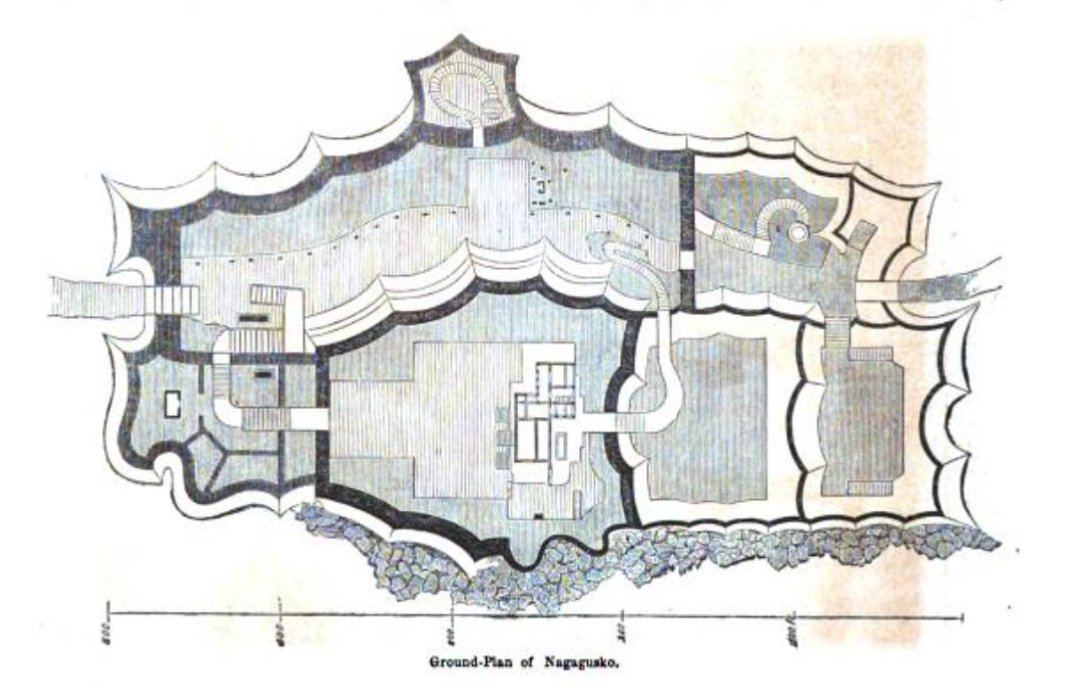
Lithograph by Heine & Brown/Public Domain
Turn to your right and head up the stairs to check out the great views of Nakagusuku Bay from the top of the wall. You'll see signs for:
- Main Hall Site
- Sacred Place of Prayer: Nakamori no Oibe - Common Name: Chigee Utaki
Make your way through the next arched stone gate into the 2nd bailey. As you transition from space to space you are reminded how much square footage this castle has. You'll see a sign for:
- Sacred Place of Prayer: Shiraitomi no Oibe
Make your way to the top of the wall, and walk along the warrior paths, where the sentinels would keep watch. While you're here take note of the sinuous lines that the walls have.
Follow the sign for "Route" down the wooden staircase and into the end of the West bailey. You'll see another "Route" sign at a gate that is shored up with wooden beams. On the other side of the gate, you'll see a sign for the Ufugaa Well.
Head down the stairs and into well area and notice all the green moss and ferns, this is a great place to cool off. When ready, head out of the well, and along the path. You'll see a sign for the Third Enclosure - also known as the Miigusuku - or new castle.
Head up the stairs. Notice the walls in the 3rd bailey (enclosure) are in the aikata (turtleback) style, where the stones are shaped to fit together organically. Pass through the massive arched stone back gate, and notice it's built of giant stone masonry, in the nuno style. This opens out into a large grassy area with a static model of the castle and hill top, it'll give you an opportunity to review what you've just seen and notice if you missed anything.
Shuri Castle (首里城)
⭐⭐⭐ Great

Savannah Rivka, CC BY-SA 4.0
Castle Data
- Dimensions: 400 m x 270 m
- Constructed: 14-16th century
- Lat/Long: 26.2172,127.7205
- Google Maps: Shuri Castle
- Elevation: 100 m
Points of Interest
- Shuri Castle is a UNESCO World Heritage Site (972-007)
- Shureimon Gate
- Seidan Mail Hall (burned in 2019, under construction)
- Beautifully reconstructed gates, gatehouses, doors, buildings
- Agari-no Azana viewing point on the eastern wall
- On site Shuri Castle Teahouse (see Where to Eat, below)
- 32nd Army Underground Headquarters 第32軍司令部壕
- Benzaitendo 弁財天堂 and Enkachi Pond 円鑑池
- Enkakuji Temple
Getting There and Parking
- Distance: 7 km east of Naha Airport
- Car: Navigate to Nakagusuku Castle, 503 Ogusuku, Kitanakagusuku, Nakagami District, Okinawa 901-2314, Japan. (中城城跡)
- Parking: 100 vehicles in Shuri Parking 1 & 2 see https://oki-park.jp/shurijo/en/access/192
- Restrooms: 3 inside the main castle and 6 on site
- Admission: 400¥ for adults and 300/160¥ students and free for under 6.
- Hours: 8:00 am - 8 pm - depending on season and paid/unpaid areas
- Access: Wheelchair accessible and available free of charge
- https://oki-park.jp/shurijo/en/
Where to Eat
- Shuri Castle Teahouse 首里城茶屋, 3 Chome Shuritonokuracho, Naha, Okinawa 903-0812, Japan. https://oki-park.jp/shurijo/guide/161
- Restaurant Suimui レストラン首里杜(すいむい), 1 Chome-1 Shurikinjocho, Naha, Okinawa 903-0815, Japan. https://oki-park.jp/sp/shurijo/guide/59/7412
Side Trip
- Kanagusiku-murayaa House 金城村屋(かなぐしくむらやー), 2 Chome-7 Shurikinjocho, Naha, Okinawa 903-0815, Japan. https://www.city.naha.okinawa.jp/kurasitetuduki/collabo/tosi/dezain/kinjyoumuraya.html
- Kinjo Stone Road 首里金城町石畳道, 2 Chome Shurikinjocho, Naha, Okinawa 903-0815, Japan. https://www.city.naha.okinawa.jp/kankou/kankou/rekisi.html
Maps - Shuri Castle

Map data ©2025 Google

Map data ©2025 Google
Overview - Shuri Castle
Okinawa, known for its laid-back vibe and stunning coastline, holds a hidden gem—Shurijo Castle, the majestic heart of the former Ryukyu Kingdom. Forget the typical Japanese castle image—Shurijo is a fascinating blend of cultures. It's like stumbling upon a dash of Forbidden City grandeur right in Okinawa!
Shurijo Castle, perched atop a hill overlooking Naha, served as the royal residence and the kingdom’s political and cultural hub from 1469 until 1879. Sadly, the castle we see today is a meticulously researched reconstruction. Fires in 1453, 1660, and 1709, and the devastating Battle of Okinawa in 1945, and 2019 left the castle in ruins.
Wander through the castle grounds, and you'll see a captivating mix of Chinese, Japanese, and Ryukyuan architectural styles—a testament to the kingdom's role as a trading crossroads. The Seiden (main hall), while currently under reconstruction due to another fire in 2019, was a prime example of this fusion, showcasing influences from both China and Japan. Be sure to admire the Shureimon Gate, a masterpiece of traditional Chinese pailou architecture.
Strolling through Shurijo Castle is like stepping back in time. It's a journey through the legacy of the Ryukyu Kingdom and a reminder of Okinawa’s unique cultural tapestry.

nnh, Public domain, via Wikimedia Commons
On The Trail - Shuri Castle
Hey there, fellow travelers! Get ready for a journey back in time as we explore Shurijo Castle, the crown jewel of Okinawa and a symbol of the Ryukyu Kingdom's vibrant past. Now, forget those cookie-cutter Japanese castles you might have in mind—Shurijo is a unique blend of architectural styles, a cultural cocktail with dashes of Chinese, Japanese, and, of course, Okinawan flair. It's like stepping into a captivating blend of the Forbidden City and a traditional Okinawan village!
Our adventure begins at the iconic Shureimon Gate, a symbol of Shurijo and a star attraction in its own right! Built in the distinctive pailou style of Chinese ceremonial gates, this bright red beauty hints at the cultural fusion we'll encounter throughout the castle grounds.
As we pass through the gate, imagine the hustle and bustle of centuries past—officials going about their duties, artisans crafting their wares. Today, this outer bailey gives us a taste of Shurijo's former life as a center of government and commerce.
Let's follow the path leading up to the inner bailey, but keep your eyes peeled for these historical highlights along the way:
- Ryūhi (Dragon Well): This isn't your average watering hole! Check out the intricately carved dragon sculpture dating back to 1523, a gift from China that speaks volumes about the Ryukyu Kingdom's close ties with the mainland. And hey, see those stones over there? That marks the spot where archaeologists unearthed a broken tablet—a piece of a poem praising the well's pure water—that they were later able to match with its missing half in a museum. Talk about a historical puzzle solved!
- Kankamon Gate: As we approach the inner bailey, this gate's name, meaning “welcome,” reminds us that we're entering a more exclusive area. During the Ryukyu Kingdom, envoys from China were greeted here with pomp and ceremony. Those fierce-looking shisa (lion-dog statues) you see flanking the gate? They’re traditional guardians meant to ward off evil spirits—you'll see them throughout Okinawa!
- Ryusenmon Gate: This gate takes its name from the nearby Ryūhi and showcases a classic Ryukyuan architectural feature—a wooden tower perched atop a sturdy stone archway. It's a blend of practicality and aesthetics that defines the Ryukyuan style.
- Roukokumon Gate: Meaning “water clock gate,” this structure once housed a clever time-keeping device. Imagine a water clock atop the gate, ticking away the hours, with officials striking a bell to announce the time to the castle and beyond
As we continue our ascent, we'll reach the Koufukumon Gate, which once housed government offices—talk about an office with a view! Today, it's a prime spot to soak in breathtaking panoramas of the castle grounds and Naha city sprawling out below.
Now, before we enter the heart of Shurijo Castle, let's take a moment to appreciate the walls themselves. Notice their unique, undulating shape—a hallmark of Ryukyuan castle architecture. These walls weren't just about defense; they were designed to blend seamlessly with the natural landscape, reflecting the Ryukyuan belief in living in harmony with nature.
Passing through the Houshinnmon Gate, the last gate before the inner bailey, we enter a realm where rituals and ceremonies once dictated the rhythm of life. During the Ryukyu Kingdom, this gate was the setting for a daily ritual marking the opening of the castle, a symbolic transition from night to day.
While the Seiden (main hall), tragically destroyed by fire in 2019, is currently undergoing meticulous reconstruction, we can still envision its former glory. This grand, two-story structure, resplendent in red lacquer, was the heart of the Ryukyuan court. It's here that kings held court, received dignitaries, and presided over elaborate ceremonies.
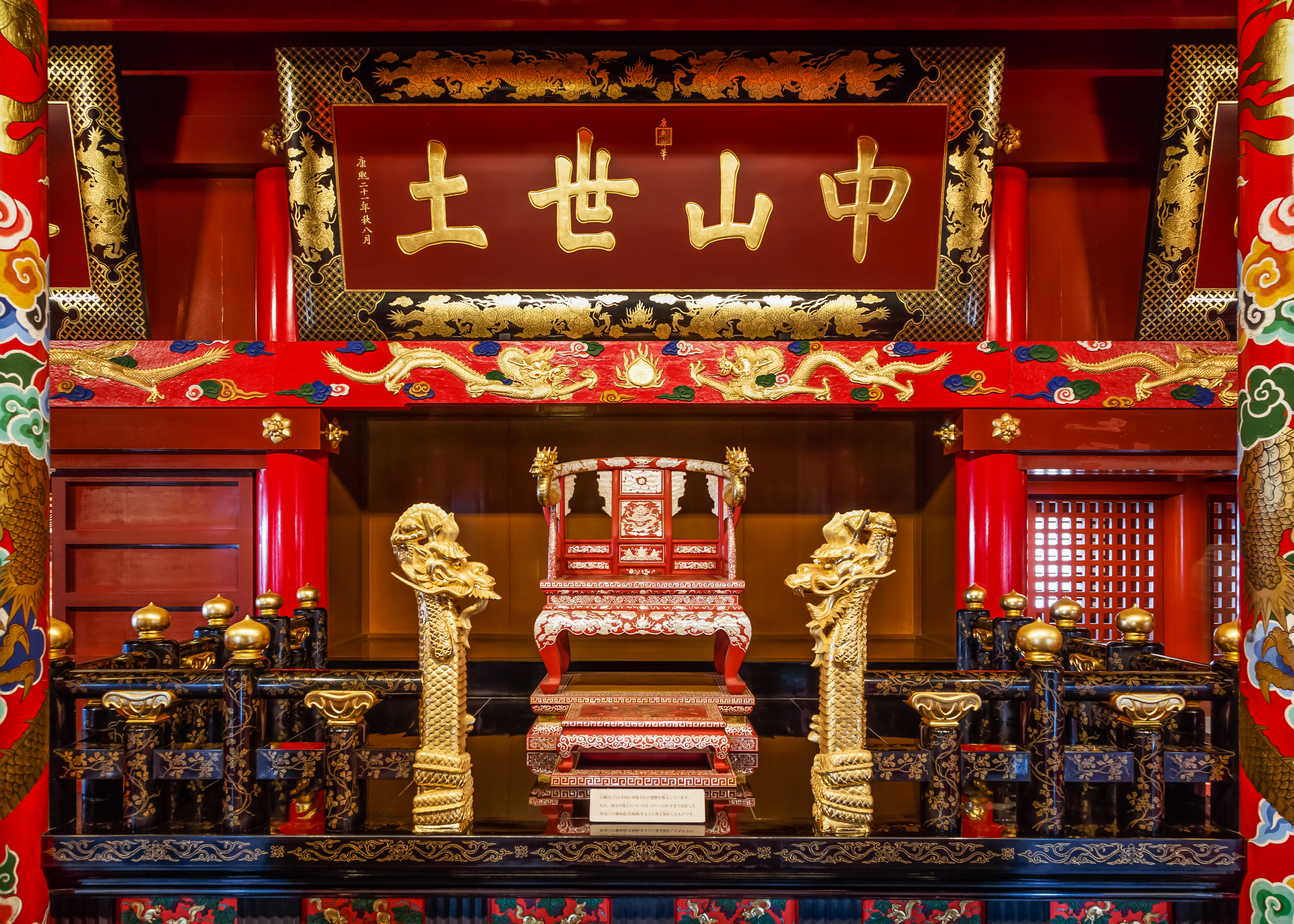
Photo by CEphoto, Uwe Aranas
Venturing deeper into the inner bailey, we'll discover:
- Kyo no Uchi: This tranquil wooded area wasn’t just any garden—it was the spiritual heart of Shurijo Castle, where priestesses known as kikoe-ookimi performed rituals to ensure the kingdom’s prosperity, safe voyages, and bountiful harvests. Close your eyes for a moment and imagine the scent of incense, the chanting of priestesses, the rustling of leaves—the atmosphere must have been magical.
- Yohokoriden: This building once housed the unmarried princesses of the Ryukyu court—imagine the stories these walls could tell! Today, the Yohokoriden has been adapted for a modern purpose: a theater showing a film about Shurijo Castle and the Ryukyu Kingdom. It's a fantastic way to delve deeper into the history and legends we’ve just explored.
Our journey doesn't end here! Let's continue our exploration of Shurijo Castle by seeking out some hidden gems:
- Agari-no-Azana: For a bird's-eye view of the castle and the surrounding area, head to the Agari-no-Azana, an observation point located on the eastern side of the castle walls. From here, you can appreciate the strategic brilliance of Shurijo’s hilltop location, offering commanding views of Naha and the coastline beyond.
- 32nd Army Underground Headquarters: This network of tunnels, located beneath the castle grounds, offers a poignant reminder of the Battle of Okinawa during World War II. The tunnels served as a command post for Japanese forces and are now a sobering memorial to the lives lost during the battle.
After exploring the castle, take a short walk to discover:
- Benzaitendo and Enkachi Pond: Located just outside the castle's main entrance, this serene oasis offers a moment of tranquility amidst the historical grandeur. Stroll across the red-lacquered Tennyobashi Bridge to reach the Benzaitendo, a small hall dedicated to Benzaiten, the goddess of music, knowledge, and good fortune. The pond itself was once part of a sophisticated water system that channeled water from the hills to the castle.
- Enkakuji Temple: This temple, dating back to 1492, once served as the most important center of Zen Buddhism in the Ryukyu Kingdom. Although it was largely destroyed during the Battle of Okinawa, the temple's main gate, several stone walls, and the Hojo Bridge, a nationally designated Important Cultural Property, have been restored.
As we conclude our tour, take a moment to appreciate the indomitable spirit of Shurijo Castle. Rebuilt time and again after fires and war, it stands as a powerful symbol of Okinawan heritage and the enduring legacy of the Ryukyu Kingdom. This isn't just a collection of old stones and reconstructed buildings—it's a testament to the power of culture to endure and inspire.
Urasoe Castle (浦添城)
⭐⭐ Good
あばさー, Public domain, via Wikimedia Commons
Castle Data
- Dimensions: 380 m x 70 m
- Constructed: 14th century
- Lat/Long: 26.2479, 127.7291
- Google Maps: Urasoe Castle Ruins
- Elevation: 130 m
Points of Interest
- Urasoe Castle Museum
- Castle Gate and walls (reconstructed)
- Stone road
- Castle wall ruins
- Urasoe Yudore (Tomb of Chuzan Kings Eiso & Sho Nei)
- Hacksaw Ridge
- Maeda Escarpment Tunnel Network
- Kuchiguagama Cave
Getting There and Parking
- Distance: 13 km east of Naha Airport
- Car: Navigate to Urasoe Gusuku and Youdore Museum, 2 Chome-53-1 Nakama, Urasoe, Okinawa 901-2103, Japan. (浦添グスク·ようどれ館)
- Parking: 3 locations in the area for about 20 vehicles at the museum and an additional 20 at Hacksaw Ridge Car Park
- Admission: 100 Y adults, 50 Y children
- Hours: 9am-5pm
- Access: unknown
- Restrooms: 2 on site, 4 in the area
- City Site
- English Map
Where to Eat
- Takaesu Soba, 高江洲そば, 3 Chome-36-1 Iso, Urasoe, Okinawa 901-2132, Japan. https://tabelog.com/en/okinawa/A4703/A470404/47000071/
- Sushiro Urasoe Barclays Court, スシロー 浦添バークレーズコート店. 2 Chome-2-4 Toyama, Urasoe, Okinawa 901-2104, Japan. https://www.akindo-sushiro.co.jp/shop/detail.php?id=357
Side Trip
- Urasoe Art Museum, 浦添市美術館, 1 Chome-9-2 Nakama, Urasoe, Okinawa 901-2103, Japan. https://urasoe-artmuseum.jp/
- Urasoe Grand Park, 浦添大公園 憩いの広場 遊具エリア, 1 Chome-12-5 Toyama, Urasoe, Okinawa 901-2104, Japan. https://www.urasoedaipark-osi.jp/ikoi.php
Maps - Urasoe Castle

Map data ©2025 Google

Map data ©2025 Google
Overview - Urasoe Castle
Urasoe Castle (浦添城), also known as Urashii Gushiku, was a significant Ryukyuan gusuku that served as the capital of the Chuzan principality during the Sanzan (3 mountain) period. Before Okinawa Island's unification into the Ryukyu Kingdom and the move of the capital to Shuri, Urasoe was the most powerful of the three kingdoms. Historically, it was the largest castle on the island in the 14th century. While only ruins remain today, located behind the modern city of Urasoe on the northern edge of Naha, recent excavations have helped to reveal its full picture.
The castle site spans approximately 380m from east to west and 60m to 80m from north to south. It is situated on the eastern end of a Ryukyu limestone hill at an elevation of about 130m-144m. The site is divided into two sections: the eastern Kogusuku (old castle) and the western Migusuku (new castle).
Urasoe Castle is believed to represent the first instance of a major shift in the construction of elite structures and gusuku in Okinawa, thought to have been grander in scale and complexity than previous sites. Some scholars believe that the structure and features later seen at the royal capital in Shuri were already complete at Urasoe, pointing to evidence of wealth, power, and aesthetic grandeur. This is supported by archaeological findings of imported goods like Korean roof tiles and Chinese stone coffins, which indicate extensive trade and diplomatic connections. The castle's strategic location utilized sheer cliffs and the sea for defense in its upper portions, while ramparts, palisades, and a moat defended the lower parts.
Urasoe served as the headquarters of Chuzan until its overthrow by Sho Hashi, who then unified the three kingdoms and moved the capital to Shuri, after which Urasoe is presumed to have been abandoned as the capital. The castle suffered significant damage historically, being burned and destroyed in the 1609 invasion by Satsuma. More recently, it was a site of intense fighting during the Battle of Okinawa in WWII (known to the US forces as Maeda Heights or Hacksaw Ridge), where it was used as a Japanese defensive position. After the war, it was used as a US forces radar station, leading to further destruction of walls. The castle and ridge were heavily damaged by battle and post-war quarrying. Archaeological investigation and restoration are ongoing. It is designated as a National Historic Site.

Zuchinniasleep3155, CC BY-SA 4.0, via Wikimedia Commons
On The Trail - Urasoe Castle
Okay, put on your walking shoes and let's explore Urasoe Castle, shall we?
Starting from the parking area, you'll follow the trail that leads you right past the Urasoe Yodore, those fascinating royal tombs dug directly into the cliffside. Look for the resting place and memorial stone of the famous Okinawan historian, Iha Fuyu, who was key in establishing Urasoe's importance as an ancient capital before Shuri.
As you wander this hilltop, you're also walking through the heart of the brutal Battle of Okinawa, known to the Americans as Maeda Heights or "Hacksaw Ridge". This ridge was a Japanese defensive position, and the fighting was fierce. You might still spot grim reminders, like old foxholes and memorial stones. The battle sadly obliterated most of the castle's above-ground structures.
But don't let that deter you! Thanks to ongoing archaeological digs and dedicated restoration work, we're starting to piece together the picture of this once-grand castle. You can see restored sections of wall, and near where the main gate is thought to have been, look for scattered wall remnants and even the original base stones unearthed by excavators. Keep an eye out for some truly impressive large stones, possibly part of the original gate, showcasing remarkable ancient masonry techniques.
As you traverse the site, particularly in the areas that have been rebuilt, notice the unique angled stone paths – they're characteristic of the architecture, similar to those at the rebuilt Urasoe Castle gates. Walking these old stones, you can almost feel the different historical eras layered beneath your feet: the ancient capital of the Chuzan kings, the scars of war, and the careful work of modern preservation. The castle itself stretches long and relatively narrow across the ridge, divided into the older Kogusuku on the east and the newer Migusuku on the west, a series of interconnected enclosures. It's a site that tells a complex, compelling story!
Zakimi Castle (座喜味城)
⭐⭐⭐ Great

Almighty Franklinstein, CC BY-SA 2.0
Castle Data
- Dimensions: 130 m x 140 m
- Constructed: 15th century
- Lat/Long: 26.4084, 127.7417
- Google Maps: Zakimi Castle Ruins
- Elevation: 127 m
Points of Interest
- UNESCO World Heritage Site (UNESCO 972-004)
- Built by the renowned Aji (local leader) Gosamaru
- Oldest existing stone arched gate in Okinawa with a unique keystone
- Views over Yomitan Village and the surrounding area
- Well-maintained ruins with restored walls and foundations
- Yuntaza Museum, 9am-6pm, 500 Y, closed Wed. http://www.yuntanza-museum.jp/
Getting There and Parking
- Distance: 32 km north of Naha Airport
- Car Route 1: Navigate to Yuntanza Historical Museum 世界遺産座喜味城跡 ユンタンザミュージアム, 708-6 Zakimi, Yomitan, Nakagami District, Okinawa 904-0301, Japan. http://www.yuntanza-museum.jp/
- Car Route 2: Navigate to Zakimi Castle Ruin Park 座喜味城跡公園, 1758 Takashiho, Yomitan, Nakagami District, Okinawa 904-0324, Japan. https://www.vill.yomitan.okinawa.jp/sections/fields/life/cat4/post-585.html#kouen02
- Parking: 2 locations. Approx 50 spots at the park to the north, and about 70 at the museum to the south
- Admission: Free
- Hours: 24 hrs
- Access: unknown
- Restrooms: 2 on site, at the north parking lot and at the museum to the south
- https://www.yomitan-kankou.jp/tourist/watch/1611289699/
- https://www.vill.yomitan.okinawa.jp/kanko_bunka_sports/rekishi_bunkazai/3682.html
Where to Eat
- Kintiti Soba 金月そ 201 Kina, Yomitan, Nakagami District, Okinawa 904-0302, Japan. https://kintitisoba.com/
- BANTA CAFE バンタカフェ by 星野リゾート, 560 Gima, Yomitan, Nakagami District, Okinawa 904-0327, Japan. https://banta-cafe.com/menu/
Side Trip
- Pottery Co-op, Yachimun no Sato やちむんの里 2653-1番地 Zakimi, Yomitan, Nakagami District, Okinawa 904-0301, Japan. https://www.yomitan-kankou.jp/tourist/watch/1611319504/
- Okinawa Kokuto (Brown Sugar Factory Store) 株式会社沖縄黒糖 2822-3 Zakimi, Yomitan, Nakagami District, Okinawa 904-0301, Japan. https://www.okinawa-kokuto.co.jp/
- Nirai Beach ニライビーチ 600 Gima, Yomitan, Nakagami District, Okinawa 904-0327, Japan
- Mie Castle (Recreation) 三重城(再現建造物) 915 Takashiho, Yomitan, Nakagami District, Okinawa 904-0323, Japan.
Maps - Zakimi Castle

Map data ©2025 Google

Map data ©2025 Google
Overview - Zakimi Castle
Step back in time at Zakimi Castle, a magnificent example of an Okinawan gusuku perched on a small plateau in Yomitan Village. Built between 1416 and 1422 by the legendary Aji, Gosamaru, using stones from nearby Yamada Castle, it served as his residence and oversaw the northern reaches of the central kingdom of Chuzan. After only about 17-18 years, Gosamaru was relocated to Nakagusuku Castle.
Today, Zakimi Castle is recognized as a National Historic Site and is part of the UNESCO World Heritage list, highlighting its historical significance. While it suffered damage during and after WWII, serving as a Japanese military position and then a US radar site, much of it has been carefully restored, making it a truly remarkable site to visit.
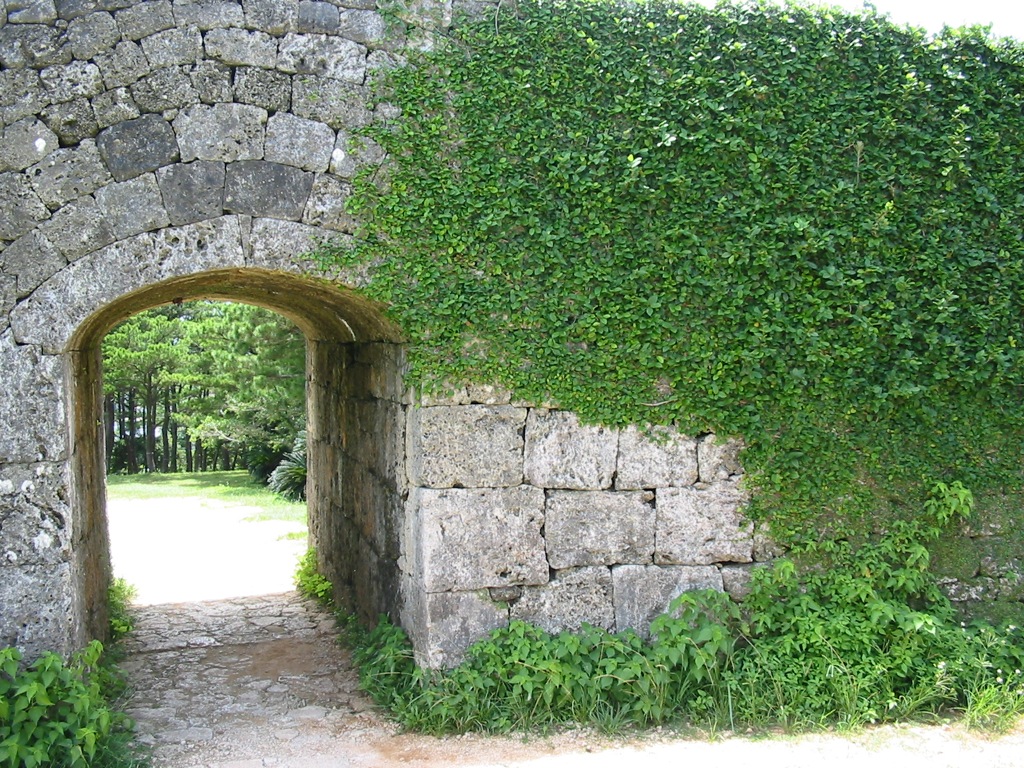
Almighty Franklinstein, CC BY-SA 2.0
On The Trail - Zakimi Castle
As you arrive at the parking area near the Yuntanza Historical Museum, take a moment to orient yourself. Look for the description board before entering the castle grounds – it's highly recommended to read it to better understand the history and layout of the site.
The castle features a renkaku-shiki layout, meaning it has two main baileys or courts. The impressive stone walls, showcasing beautiful curves, encircle both the first (一の郭) and second (ニノ郭) baileys. You can walk along some sections of the walls.
One of the most striking features is the stone arched gate (拱門) that connects the baileys. This particular gate is considered the oldest existing arched gate in Okinawa. As you pass through, look closely at the stone work, especially the keystone (クサビ石) fitted in the center of the arch – a unique characteristic of Ryukyuan masonry.
Explore the interior of the baileys. In the first bailey, you can see the foundation stones (礎石) where the palace building (殿舎) once stood. The walls here feel quite high. From the top of the wall in the first bailey, you can look out towards the second bailey's gate and appreciate the elevation.
The second bailey is a large grassy area with beautifully curved walls. You'll also notice defensive features, like the chi (雉), which are projecting sections of the wall designed as lookout points to enhance defense. The wall thickness varies, being narrower and lower in some areas and wider and higher in others. Look for the stone steps that allow access to the top of the wall for better vantage points.
While walking the grounds, remember that this site holds deep history, from the time of the Aji Gosamaru to its role in more recent conflicts. Despite the damage it has sustained, the restoration work allows us to appreciate the scale and architectural ingenuity of this important gusuku. The views from the walls are fantastic, offering a perspective similar to what the ancient guards or lords might have seen. Take your time, soak in the atmosphere, and imagine the life that once bustled within these walls over 500 years ago. Being a good cultural ambassador means respecting the historical site.
Enjoy your journey through the history of Zakimi Castle!

Piet Parkiet, CC BY-SA 4.0